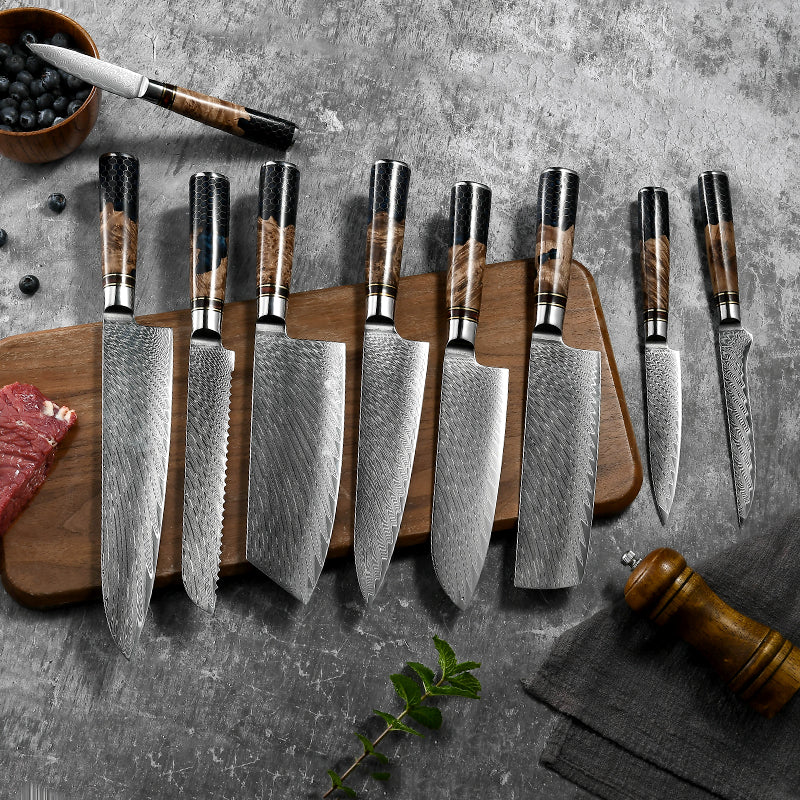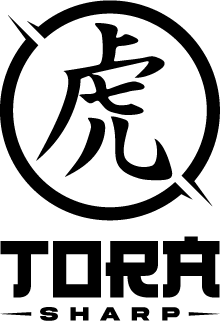
Specialty Knives and Their Uses: A Guide for Every Kitchen
Share
In the culinary world, the right knife can transform your cooking experience. While a basic chef's knife is a versatile tool, there are several specialty knives designed to handle specific tasks with precision and ease. Whether you're a professional chef or a home cook, understanding the purpose and proper use of each knife can elevate your kitchen skills. Here's a guide to some of the most essential specialty knives and their uses.
- Paring Knife
Purpose: Peeling, coring, and intricate tasks.
A paring knife is a small yet mighty tool in the kitchen, perfect for tasks that require precision. With its short, sharp blade, the paring knife excels at peeling fruits and vegetables, coring apples, and performing delicate tasks like deveining shrimp or slicing small garnishes. Its size allows for maximum control, making it indispensable for intricate work.
Key Features:
- Small, sharp blade (usually 2.5 to 4 inches)
- Easy to maneuver
- Ideal for detailed, precision tasks
- Utility Knife
Purpose: General kitchen tasks.
The utility knife is a versatile tool that sits between a paring knife and a chef's knife in size. It's perfect for tasks that are too big for a paring knife but don't require the heft of a chef's knife, such as slicing sandwiches, cutting cheese, or slicing small vegetables. Its versatility makes it a go-to knife for a wide range of kitchen tasks.
Key Features:
- Mid-sized blade (typically 4 to 7 inches)
- Versatile and multi-functional
- Great for slicing, cutting, and dicing
- Bread Knife
Purpose: Slicing bread and other baked goods.
A bread knife is easily identifiable by its long, serrated blade. This knife is designed to slice through bread without crushing it, preserving the loaf’s texture and shape. It's also excellent for cutting through cakes, pastries, and other delicate items, including tomatoes, where a straight blade might squish the food.
Key Features:
- Long, serrated blade (usually 8 to 10 inches)
- Ideal for slicing soft or crusty bread
- Can be used on delicate, soft foods without squashing them
- Nakiri Knife
Purpose: Precise vegetable chopping and slicing.
The Nakiri knife is a Japanese-style knife designed specifically for chopping vegetables. Its straight, rectangular blade allows for clean, consistent cuts without rocking the knife. The Nakiri is ideal for tasks like slicing, dicing, and chopping vegetables with precision. It’s especially useful for making thin, uniform slices, making it a favorite for preparing stir-fries, salads, and other vegetable-centric dishes.
Key Features:
- Rectangular, flat blade (typically 5 to 7 inches)
- Excellent for precise vegetable cuts
- Straight edge for consistent, clean slices
- Santoku Knife
Purpose: All-purpose chopping, slicing, and dicing.
The Santoku knife, a Japanese classic, is similar to a chef’s knife but with some key differences. Its shorter, wider blade with a flat edge is perfect for chopping, dicing, and mincing. The blade often features small indentations (called grantons) that prevent food from sticking, making it particularly effective for slicing thin cuts of meat or vegetables.
Key Features:
- Shorter, wider blade (typically 5 to 7 inches)
- Granton edge to reduce sticking
- Great for precise chopping and slicing
- Chef's Knife
Purpose: All-purpose kitchen tasks.
The chef's knife is the workhorse of the kitchen, capable of handling a wide variety of tasks. Its broad, tapered blade is ideal for chopping, slicing, dicing, and mincing. The curved edge allows for a rocking motion, making it easy to chop herbs or dice vegetables quickly and efficiently. A good chef’s knife is a must-have in every kitchen.
Key Features:
- Broad, tapered blade (typically 8 to 10 inches)
- Versatile for a wide range of tasks
- Curved edge for a smooth rocking motion
- Boning Knife
Purpose: Removing bones from meat, poultry, and fish.
A boning knife is characterized by its narrow, flexible blade, which allows for precise cuts close to the bone. This knife is essential for tasks like deboning chicken, trimming fat from meat, or filleting fish. Its flexibility helps to maneuver around joints and bones, ensuring minimal waste and clean cuts.
Key Features:
- Narrow, pointed blade (typically 5 to 7 inches)
- Flexible for maneuvering around bones
- Ideal for deboning and trimming
- Cleaver
Purpose: Chopping through bones and tough vegetables.
A cleaver is a large, heavy knife with a rectangular blade, perfect for heavy-duty tasks like chopping through bones, cutting large cuts of meat, or smashing garlic. Its weight and broad blade make it an excellent tool for splitting meat or tackling tough vegetables like squash. Despite its intimidating size, a cleaver can also be used for more delicate tasks, like finely mincing herbs or garlic.
Key Features:
- Large, rectangular blade
- Heavy and sturdy for chopping through bones
- Versatile for both heavy-duty and delicate tasks
Choosing the Right Specialty Knives for Your Kitchen
Selecting the right specialty knives depends on your cooking style and the types of foods you prepare most often. While it's tempting to buy a complete set, you may find that only a few specialty knives are necessary for your needs. For most kitchens, a combination of a chef's knife, paring knife, and bread knife is a solid foundation. As you become more comfortable, you can expand your collection to include knives like the Santoku, Nakiri, or cleaver.
Caring for Your Specialty Knives
To keep your specialty knives in top condition, follow these care tips:
- Hand wash your knives to prevent damage from the dishwasher’s heat and detergent.
- Sharpen your knives regularly to maintain a sharp edge. A sharp knife is safer and more effective.
- Store your knives properly, using a knife block, magnetic strip, or protective sheath to prevent dulling or damage to the blades.
Conclusion
Specialty knives are essential tools for achieving precision and efficiency in the kitchen. By understanding the purpose and features of each knife, you can select the right tools for your cooking needs. Whether you're slicing bread with a serrated knife, chopping vegetables with a Nakiri, or deboning chicken with a boning knife, having the right knife for the job makes all the difference. Investing in quality knives and caring for them properly will ensure that your kitchen remains a place of culinary creativity and success.
